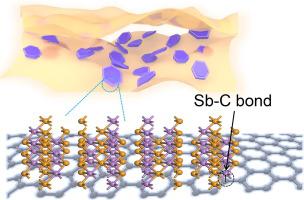Chemical Engineering Journal ( IF 13.3 ) Pub Date : 2023-02-19 , DOI: 10.1016/j.cej.2023.141957
Shaokun Chong , Shuangyan Qiao , Lingling Yuan , Qianwen Zhou , Ting Li , Shihong Dong , Yikun Wang , Meng Ma , Wei Huang

|
Anode materials with conversion-alloying dual mechanism are crucial for the development of high energy density potassium-ion batteries (PIBs), while large volume expansion and poor dynamic behavior hinder its development. Herein, nanoplate-structured Sb2Te3 anchored on graphene and N-doped C (Sb2Te3@rGO@NC) is regarded as anode material for PIBs for the first time. The dual encapsulation effect of Sb2Te3@rGO@NC composite with strong chemical bonding of Sb—C can not only significantly restrain the large volume expansion to maintain the electrode integrity, but also efficiently enhance the electronic transfer, K-ion adsorption and diffusion ability, verified by first principles calculations and electrochemical kinetics study. As a result, the resultant Sb2Te3@rGO@NC electrode delivers a high initial charge specific capacity of 384.9 mAh·g−1 at 50 mA·g−1, great rate capability and long-term lifetime over 200 cycles at 200 mA·g−1. Ex situ TEM and XPS results clarify that the electrode undergoes typical conversion-alloying dual-mechanisms with 12 mol K-ion transfer per formula employing Sb-ion as redox site (Sb2Te3 + 12 K+ + 12e- ↔ 3K2Te + 2K3Sb). This work could pave the way for the fast development of Sb2Te3-based anode for PIBs, and help to understand the K-ion storage mechanism.
中文翻译:

Sb2Te3 六方纳米板作为转化合金阳极材料,通过双碳基质的物理化学限制效应实现优异的钾离子存储
具有转化-合金化双重机制的负极材料对于高能量密度钾离子电池(PIBs)的发展至关重要,而大体积膨胀和较差的动力学行为阻碍了其发展。在此,锚定在石墨烯和N掺杂 C 上的纳米片结构 Sb 2 Te 3 (Sb 2 Te 3 @rGO@NC) 首次被视为 PIB 的负极材料。Sb 2 Te 3的双重包封效应@rGO@NC 具有强Sb—C 化学键的复合材料不仅可以显着抑制大体积膨胀以保持电极完整性,而且可以有效增强电子转移、K 离子吸附和扩散能力,通过第一性原理计算和验证电化学动力学研究。因此,所得 Sb 2 Te 3 @rGO@NC 电极在 50 mA·g -1时具有 384.9 mAh·g -1的高初始充电比容量,在 200 时具有出色的倍率性能和超过 200 个循环的长期寿命毫安·克-1。异地TEM 和 XPS 结果表明,电极经历了典型的转化合金化双重机制,每个配方使用 Sb 离子作为氧化还原位点 (Sb 2 Te 3 + 12 K + + 12e - ↔ 3K 2 Te + 2K )进行12 mol K离子转移3锑)。这项工作可为基于 Sb 2 Te 3的 PIB 负极的快速开发铺平道路,并有助于理解 K 离子存储机制。

































 京公网安备 11010802027423号
京公网安备 11010802027423号